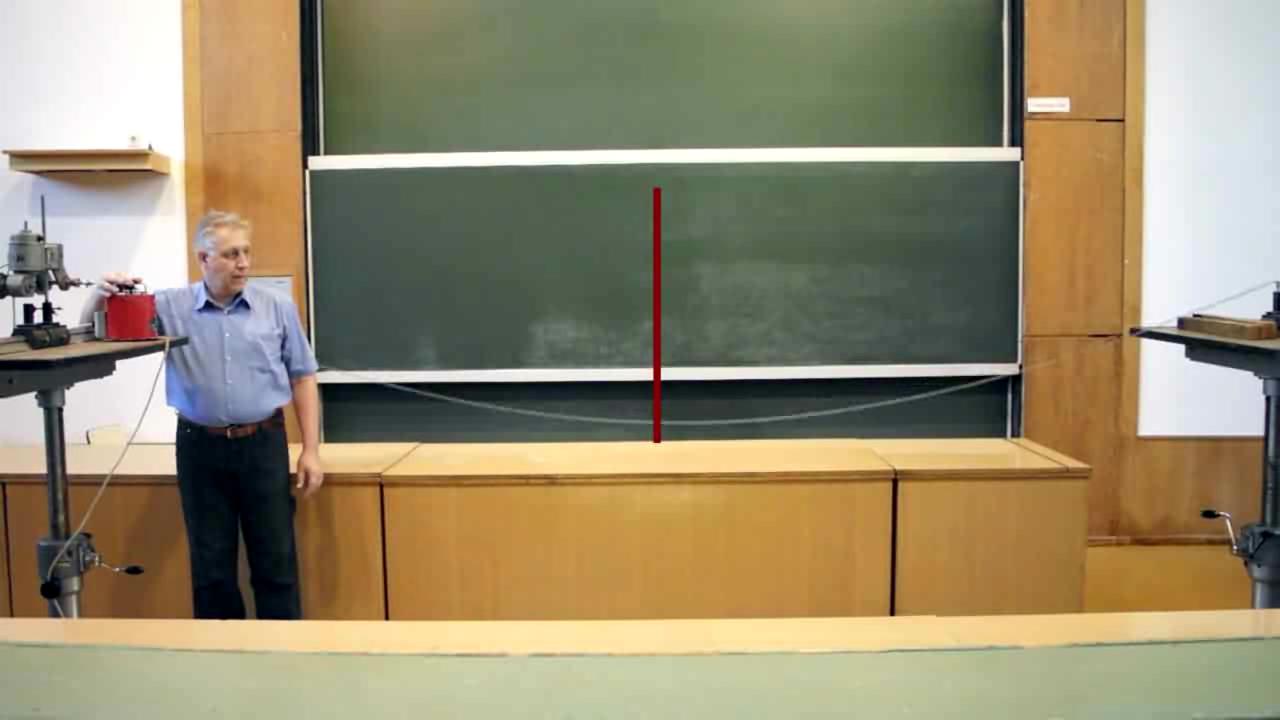„Transzverzális állóhullámok csavarrugón” változatai közötti eltérés
(Új oldal, tartalma: „Kategória:Szerkesztő:Hartlein <wikitex> thumbtime=0:30 == Az elhangzó szöveg == szöveg == angol név == ang…”) |
|||
| (egy szerkesztő 4 közbeeső változata nincs mutatva) | |||
| 1. sor: | 1. sor: | ||
[[Kategória:Szerkesztő:Hartlein]] | [[Kategória:Szerkesztő:Hartlein]] | ||
<wikitex> | <wikitex> | ||
| − | [[ | + | [[Fájl:tran_allohullamok_csavarrugon.ogv|thumbtime=0:30|bélyegkép|720px|[[Transzverzális állóhullámok csavarrugón]]]] |
== Az elhangzó szöveg == | == Az elhangzó szöveg == | ||
| − | + | Egy a keresztirányú méreteihez képest hosszú csavarrugó egyik végét rögzítsük mereven. A másik végét egy körhagyó segítségével egyre növekvő fordulatszámmal gerjesszük. A fordulatszámnak megfelelően állóhullámokat figyelhetünk meg. Elsőként a rugó teljes hosszán egy fél állóhullám figyelhető meg, a rugóközepén maximális kitérésű hellyel. A fordulatszám növelésével két félhullámot figyelhetünk meg, a rugó közepén a kitérés nulla. A fordulatszámot tovább növeleve három, négy, majd öt félhullám jelenikmeg a teljes hullámtéren, azaz a rugó hosszán. Figyeljük meg az állóhullámokra jellemző helyeket. Azokat a helyeket ahol a rezgés tágassága maximális duzzadó helyeknek, míg a nulla kitérésű helyeket csomópontoknak nevezzük. | |
| − | == | + | == Transverse Standing Waves == |
| − | + | We fix one end of a coil spring which is long in comparison to its diameter. We rotate the other end with the help of a camshaft with slowly increasing rev. Depending on the rev, we can observe certain standing waves. At first we will observe a standing wave all along the spring with the greatest amplitude in the middle of the spring. As the rev increases, we will see two half waves, and the middle of the spring will have zero amplitude. With increasing rev, we will see three, four, and then five half waves along the length of the spring. Let us note the characteristic places in a standing wave. Where the amplitude is minimal, we see a node. Where the amplitude is maximal, we see an antinode. | |
</wikitex> | </wikitex> | ||
A lap jelenlegi, 2014. március 9., 13:37-kori változata
Az elhangzó szöveg
Egy a keresztirányú méreteihez képest hosszú csavarrugó egyik végét rögzítsük mereven. A másik végét egy körhagyó segítségével egyre növekvő fordulatszámmal gerjesszük. A fordulatszámnak megfelelően állóhullámokat figyelhetünk meg. Elsőként a rugó teljes hosszán egy fél állóhullám figyelhető meg, a rugóközepén maximális kitérésű hellyel. A fordulatszám növelésével két félhullámot figyelhetünk meg, a rugó közepén a kitérés nulla. A fordulatszámot tovább növeleve három, négy, majd öt félhullám jelenikmeg a teljes hullámtéren, azaz a rugó hosszán. Figyeljük meg az állóhullámokra jellemző helyeket. Azokat a helyeket ahol a rezgés tágassága maximális duzzadó helyeknek, míg a nulla kitérésű helyeket csomópontoknak nevezzük.
Transverse Standing Waves
We fix one end of a coil spring which is long in comparison to its diameter. We rotate the other end with the help of a camshaft with slowly increasing rev. Depending on the rev, we can observe certain standing waves. At first we will observe a standing wave all along the spring with the greatest amplitude in the middle of the spring. As the rev increases, we will see two half waves, and the middle of the spring will have zero amplitude. With increasing rev, we will see three, four, and then five half waves along the length of the spring. Let us note the characteristic places in a standing wave. Where the amplitude is minimal, we see a node. Where the amplitude is maximal, we see an antinode.
